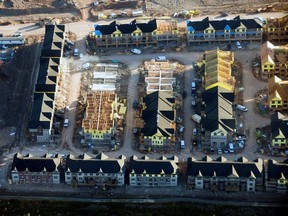John Stackhouse and Gervan Fearon: We need a new plan that changes how we design, construct, renovate and heat homes
Article content
Canada’s two biggest policy issues — climate change and housing affordability — are on a collision course.
Advertisement 2
Article content
By 2030, we need nearly six million new homes to make housing more affordable for the current generation and accommodate the next one. But if we build those homes using traditional approaches of the past four decades, we risk adding 20 per cent more emissions to a footprint that’s already the third largest in Canada.
Article content
How quickly we address these colliding challenges will be defining for all Canadians and that’s why we need a new greenprint that changes how we design, construct, renovate and heat our buildings. And we’ll need leadership from every corner of Canada — government at all levels, property developers, energy producers, cement and steel makers, cleantech entrepreneurs and more.
Progress is being made. The recent launch of the Brookfield Sustainability Institute at George Brown College featured developers who are implementing sustainable building approaches to homes and condos, and insights from banks like Royal Bank of Canada who are examining new financial mechanisms to advance green building.
Advertisement 3
Article content
And with governments focusing more on affordable housing, we are seeing new collaboration opportunities to de-risk technologies, forge partnerships, and create incentives to make sustainability the industry norm.
So, how do we build on this progress?
The first place to start is how we power our homes. Here, Canada is, to borrow a building term, at a hinge point. We rely on an abundance of natural gas for our homes and, despite heat pumps being a low-emissions alternative, it is not yet cost effective for Canadians to install one. Clean electricity regulations coming this summer will significantly change that. But if we electrify buildings in the wrong way, we risk shocking the system with dramatic increases in electricity rates for Canadians who already struggling with affordability.
Article content
Advertisement 4
Article content
To ease the cost of the transition on Canadians, every province must find ways to generate and transmit more electricity at lower costs and with fewer emissions. Thankfully, Canada is a leader in researching new electricity generation technology, so accelerating these technologies to market will be crucial.
We can then examine the materials used to build buildings — cement, steel, and the like, which account for as much as 30 per cent of a building’s overall carbon footprint. These materials can also add nearly two decades of emissions to the operation of the building.
Because Canada is among the world’s leaders in green steel and other sustainable construction materials, we have options. A new wave of mass timber projects, led by Limberlost Place on George Brown College’s downtown waterfront campus, is showing the promise of net-zero buildings. Carbicrete in Montreal is taking one of Canada’s most stubborn emissions challenges — concrete — and turning it into a powerful carbon sink. Mattamy Homes’ Springwater community in Markham, Ont., is completely net zero ready, featuring homes heated and cooled using geo-exchange technology that reduces emissions by 75 per cent.
Advertisement 5
Article content
We’ll need more of this ambition but under current codes and legislation, putting these projects into action requires exemptions and modifications that add time and money to a project.
Ambitious changes to zoning and codes could spur the development of new communities, closer to mass transit, with smaller, more affordable starter homes. They’d offer more sustainable houses to more Canadians, revitalizing urban communities rather than enabling suburban sprawl.
Changes like these can also enable provinces and cities to better support builders and their suppliers in making using low-emissions materials — new and recycled — business as usual. For inspiration, we can look to Europe where the EU-wide building reporting tool is harmonizing approaches and concepts across the continent. And, Paris, with the 2024 Summer Olympics approaching, passed a law to ensure that all new public buildings will be built with at least 50 per cent timber or sustainable materials.
Advertisement 6
Article content
The federal government is leading the way with green procurement standards that can help address the embodied emissions of buildings. With more funding, co-ordination and support, that thinking can enhance the effectiveness of programs like Buyers for Climate Action so it can be easier for provinces and cities to adopt and implement green procurement policies.
We needn’t limit our imagination to just new builds. The country’s catalogue of aging hospitals, schools, public housing and offices gives us a readymade opportunity to scale the retrofit economy in Canada. Toronto is showing its leadership with programs like Taking Action on Tower Renewal. The initiative dedicates millions of dollars to implement retrofits that reduce emissions and improve affordability, while protecting tenants from rent increases or renovictions.
Advertisement 7
Article content
The country’s major pension funds, which oversee vast portfolios of shopping malls, office towers and apartment blocks, can take more ownership of the challenge, too. One example: Quadreal, an arm of the BC Investment Management Corp., is using data from carbon audits — not energy audits — to inform property level transition plans in its own portfolio. It’s then sharing that data with industry partners and peers to drive the industry towards net zero.
We’ll still need more. Successive federal and provincial governments have offered tax breaks for energy retrofits. And yet, demand has usually fallen short of expectations. As Canadians look toward 2030, and an ambitious national target of emissions cuts, we all have a greater role to play, whether it’s investing in heat pumps, demanding cleaner fuels from our gas suppliers, or scrutinizing solar panels the way we do marble countertops.
Advertisement 8
Article content
These challenges inspired the RBC Climate Action Institute to team up with the Brookfield Sustainability Institute to map out the costs of inaction and benefits of getting to work. Our research report, High Rise, Low Carbon, estimates that it will cost Canada tens of billions of dollars each year. Plenty of jobs and economic activity will come with that transition, but we need new ways to finance that investment and scale the technologies that can accelerate change. Using these insights, we have launched a climate-smart buildings coalition with EllisDon and Mattamy Homes to put ideas into action that others can copy and improve.
This may seem like a daunting challenge when so many of the world’s emissions come from elsewhere — but that’s never stopped Canadians from showing the world what sustainable, livable, and beautiful communities can look like. We’ve produced legendary architects like Frank Ghery, transformative developers like Brookfield Corp., bold civic ambitions like Montreal’s Habitat 67, and we staged the first green Olympics in Vancouver in 2010.
Advertisement 9
Article content
-

Cement manufacturers offer up ‘interesting’ plan to cut emissions
-

Edmonton picked for the world’s first net-zero cement plant
We may be on a collision course but Canada’s reputation of innovation and leadership are recognized around the world. This spirit of sustainable innovation has helped us make some of the world’s harshest environments livable and appealing to millions from around the world. We will need that creativity and gumption more than ever, as we take on the greatest building projects of our time.
John Stackhouse is senior vice-president in the Office of the CEO at Royal Bank of Canada, leading the organization’s research and thought leadership on economic, technological and social change. Gervan Fearon is president of George Brown College.
Canada needs a greenprint for the next housing boom
2023-06-04 13:00:13







Comments
Postmedia is committed to maintaining a lively but civil forum for discussion and encourage all readers to share their views on our articles. Comments may take up to an hour for moderation before appearing on the site. We ask you to keep your comments relevant and respectful. We have enabled email notifications—you will now receive an email if you receive a reply to your comment, there is an update to a comment thread you follow or if a user you follow comments. Visit our Community Guidelines for more information and details on how to adjust your email settings.
Join the Conversation